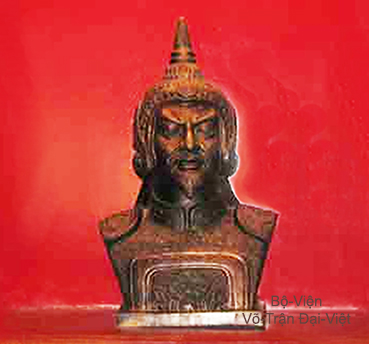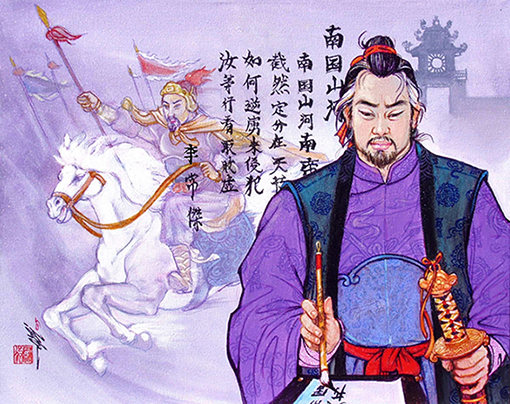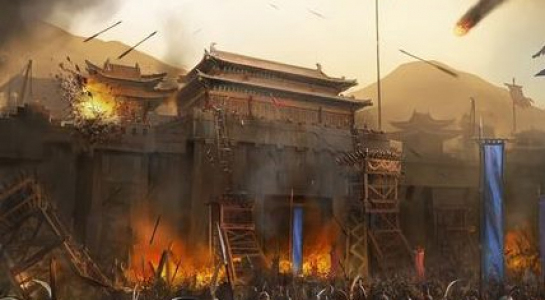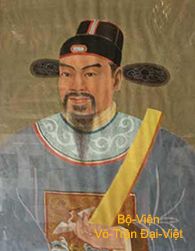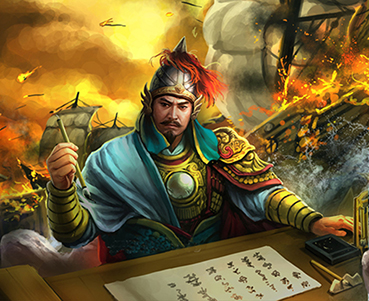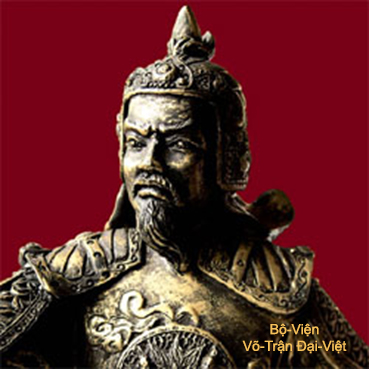I.
The Medieval Military Statute of Đại-Việt
With regard to Military Statute of LÝ Dynasty (1010-1225) until the one of TRẦN Dynasty (1225-1413), we see that Ðại-Việt owned a powerful Cavalry tradition.
There was precisely thanks to Ðại-Việt cavalry's troops perfectly trained that illustrious generalisimo LÝ-Thường-Kiệt from LÝ Dynasty had valorously pacified the CHAMPA Kingdom and defeated SONG Armies, that - with the courage of General Trần-Nhật-Duật - our illustrious general in chief TRẦN-Hưng-Đạo from TRẦN Dynasty had gloriously broken down millitary campaigns pincers from mongols armies of Toa-Đô (Sogetu) coming up from southern CHAMPA Kingdom and of Thoát-Hoan (Toghane) pourring into the northern lands, as well as he could efficiently attack by pestering Mongol troops throughout victorious battles of Đông-Bộ-Đầu, Chương-Dương, Hàm-Tử, bringing a beneficial support to Ðại-Việt Navy Forces of Amiral Trần-Quang-Khải in order to vanquish Mongols navy fleet of O-Mã-Nhi (Omar) in the Battle de Bạch-Đằngremained celebrious for ever.
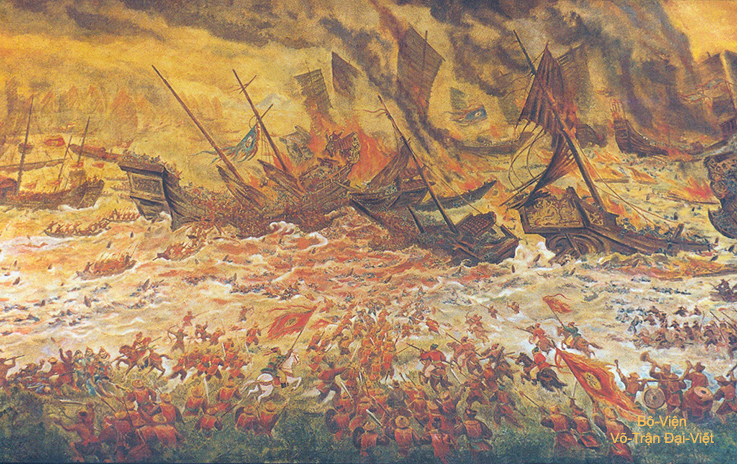
Painting of Đại-Việt Cavalry intervening in the pestering of Yuan-Mongol Navy Fleet
during the Invasion of Đại-Việt in 13th century.
- Painting by Lê Năng Hiền -
(Photo Credit : divingarchaeology.com)
A - Medieval Military Statute of LÝ Dynasty (1010-1225)
In the year of 1059, Emperor Lý-Thánh-Tông (1054-1072), from LÝ Dynasty (1010-1225) established the famous Military Statute of Ðại-Việt :
The military force of LÝ owned Eight Ensigns (Quân-hiệu) :
1. Ngũ-Long ;
2. Võ-Thắng ;
3. Long-Ðức ;
4. Thần-Ðiện ;
5. Bổng-Thánh ;
6. Bảo-Thắng ;
7. Hùng-Lược ;
8. Vạn-Tiệp.
Each Ensign (Hiệu) included Four Registers (Bộ) : Left Wing, Right Wing, Vanguard, Rearguard (Tả, Hữu, Tiền, Hậu), made up of Cavalry and Artillery (using as well Bows and Crossbows as Catapults).
Thus, LÝ's military force was comprised of :
1 - The Principal Army (Chính-Binh), included 9 Units (Ðơn-Vị) under the command of Nine Generals of Circonscriptions. Each Unit (Ðơn-Vị) includes 100 Sections (Ðội), altogether that comes to 900 Sections of Cavalry and Artillery, using Catapults, Bows and Crossbows.
2 - The Sationed Army (Trú-Chiến Binh) included statinoned troops and finghting on place.
3 - The Army of Extension (Thác-Chiến Binh), composed with mobile troops used in attacks and for extending fighting lines. The Generals of this Army of Extension commanded all each the 4 Registres (Bộ) : Left Wing, Right Wing, Vanguard, Rearguard, including Cavalry and equiping oneself identical weapons.
4 - The Army of Alternately Guard (Phiên-Binh), included troops grouped by native country, forming separate Sections (Ðội) for looking after in turn fortified towns and citadels.
The famous LÝ's Military Statute in this time had obliged Thái-Diên-Khánh (Cài Yán Qìng - 蔡 筵 磬), the chinese Prefet of Hoạt-Châu (Huo Zhou - 活 州), country bordering Ðại-Việt, to make a report so that the Emperor Tống-Thần-Tông (宋 真 宗 - Song Zhen Zong, 1068-1085) of SONG Dynasty could inspire at it.
Generalissimo LÝ-Thường-Kiệt |
Generalissimo LÝ-Thường-Kiệt
|
李常傑 |
Nam quốc sơn hà
LÝ-Thường-Kiệt |
Rivers and Mountains of Southern Kingdom Over Rivers and Mountans of Southern Kingdom reigns Southern Emperor LÝ-Thường-Kiệt |
This military force from LÝ Dynasty (1010~1025) had allowed to permit Đại-Việt Generalissimo LÝ-Thường-Kiệt, not only to pacify the Champa and to preserve of SONG invasion, throughout the victorious siege laid to the Fortress of Ung-Châu in the year 1077 and the conquest of two great southern chinese provinces, Guang-Xi and Guang-Dong in 11Ith century, but still to vainquish SONG Armies in the decisive Battle on the River of Như-Nguyệt ( River Cầu) in the year of 1077.
.
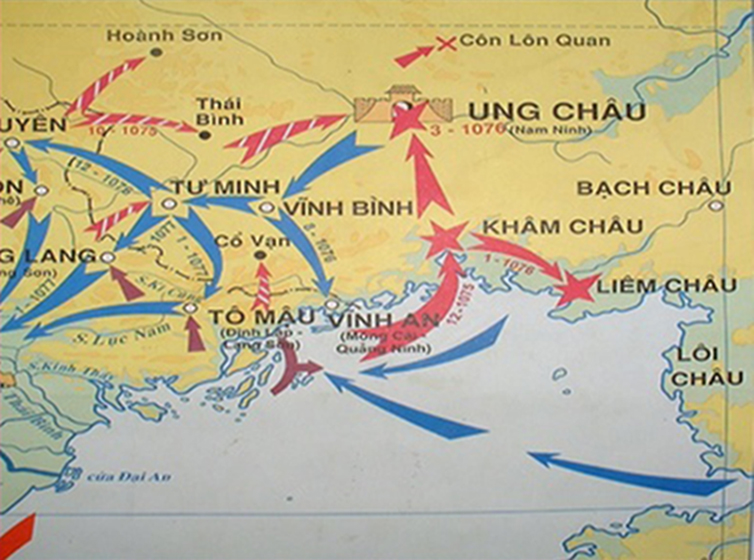
Scheme of the storming of Ung-Châu Fortress in 1076.
- Arrmies of ĐẠI-VIỆT in the year 1075 (Red Arrows) and Arrmies of SONG in the year 1077 (Blue Arows) -
(Credit Photo : thuvienlichsu.com)
The illustrious Đại-Việt Generalissimo Lý-Thường-Kiệt pulled down
|
Valiant and Loyal Generalissimo
|
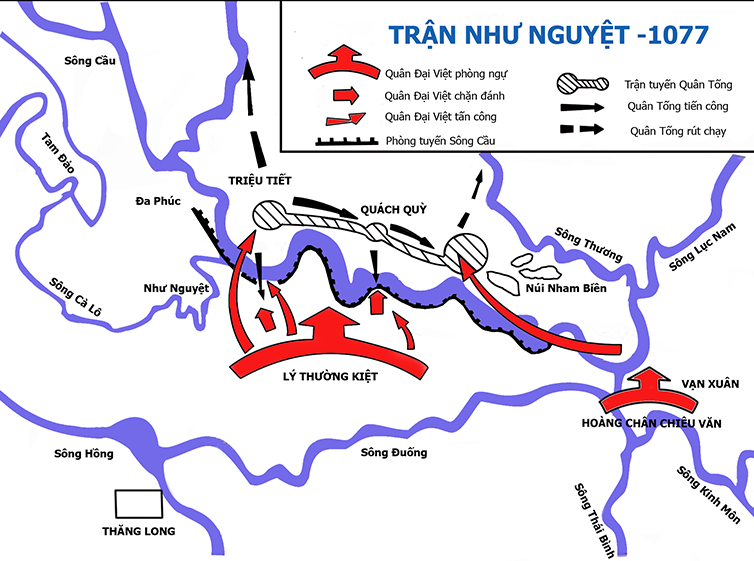
Scheme of the decisive Battle on the River of Như-Nguyệt (River Cầu)
in the War between Song and Đại-Việt (1075-1077).
(Credit Photo : wikipedia.org - Lưu-Ly)
B - Medieval Military Statute of TRẦN Dynasty (1225-1413)
Emperor Trần-Thái-Tông (1225-1258) establshed the Military Statute of Ðại-Việt as below :
In the year 1245, he selectionned robustes young Men for the Army, divided into Three Classes : Superior, Medium and Inferior.
In the year of 1246, the court of Trần established two kinds of Army : it was of Túc Vệ Binh and Thượng-Đô Túc-Vệ Binh.
On lunar month of February from this year 1246, the court of TRẦN made select men in order to form Túc Vệ Binh comprising Three Armies (Tam Quân) :
1 - Appartenance Celestian Army (Quân Thiên-Thuộc) ;
2 - Saints Virtu Army (Quân Thánh-Đức) ;
3 - Gods Tactical Army (Quân Thần-Sách).
Each Armie includes Four Armies of Defence (Tứ-Vệ-Quân), that why these Three Armies (Tam Quân) are still called :
- Four Celestian Armies (Tứ Thiên-Quân) ;
- Four Saint Armies (Tứ Thánh-Quân) ;
- Four Divine Armies (Tứ Thần-Quân).
On lunar month of February from the year of Buffalo 1247, the court of TRẦN made select strong men and knowing Martial Arts in order to remplir le rôle of Assistants for Superior Officers (Thượng-Đô Túc-Vệ).
The military power is divided into Six Paths (Lục Lộ) :
1. Thiên-Trường Path (native land of TRẦN, in nowadays Prefecture of Xuân-Trường, belonging to the Province of Nam-Định)
2. Long-Hưng Path
3. Hồng Path (in nowadays Hải-Dương)
4. Khoái Path (in nowadays Hưng-Yên)
5. Trường-Yên Path (in nowadays Ninh-Bình)
6. Kiến-Xương Path (in nowadays Thái-Bình)
For Two Paths : "Thiên-Trường Path" (native land of TRẦN, in nowadays Prefecture of Xuân-Trường, belonging to the Province of Nam-Định) and "Long-Hưng Path", Four Armies (4 Quân) were established :
- Army of Nội Thiên-Thuộc
- Army of Thiên-Cương
- Army of Chương-Thánh
- Army of Củng-Thần
For Two Paths : "Hồng Path" (in nowadays Hải-Dương) and "Khoái Path" (in nowadays Hưng-Yên) Two Armies (2 Quân) were established :
- Army of Left Wing (Tả Thánh-Đức)
- Army of Right Wing (Thánh-Đức)
For Two Paths : "Trường-Yên Path" (in nowadays Ninh-Bình) et "Voie Kiến-Xương" (in nowadays Thái-Bình) Two Armies (2 Quân) were established :
- Army of Thánh-Đức
- Army of Thần-Sách
The number of remaining selected men were posted to "Imperial Guard " (Cấm-Vệ Quân) divided into 3 Ranks included in Brigade of Marine "Trạo-Nhi Đội".
This establishment of Military Statute from Ðại-Việt in the Year of 1245 of Emperor Trần-Thái-Tông (1225-1258) previously quoted was perfected according to real-life military experiences bequeathed by LÝ Dynasty.
And that was precisely thanks to the acquisition of a valiant and powerful Armed Force all by benefiting an unanimously decided union of the whole people on the lands of Đại-Việt (tfrom the people Việt having the majoriy (appelé peuple Kinh) untill minority ethnic people) that illustrious Generalissimo Trần-Hưng-Đạo and Military Officers from TRẦN Dynasty - at the Đông-Bộ-Đầu Battle - had dềated 30.000 Yuan-Mongol combatants and nearly 20.000 combatants from Đại-Lý (Yunan) - in total almost 50.000 invaders combatants - and putting an end in 15 days to the 1st War between Yuan-Mongol & Đại-Việt in the Year of 1258.
Generalissimo Trần-Hưng-Đạo
|
Generalissimo Trần-Hưng-Đạo |
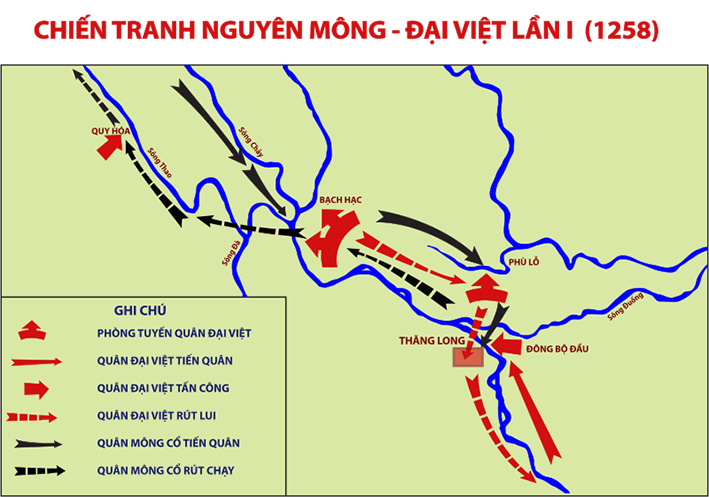
Scheme of the 1st War between the Yuan-Mongols and the Đại-Việt in 1258.
(Tín-Dụng ảnh : wikipedia.org - Lưu-Ly)
On lunar month of February from the year of Hen 1261, Emperor Trần-Thánh-Tông (1258-1578), three years afterwards his accession to the throne, made recruit militairies in various Paths (Lộ) : strong men were selected to be Soldiers, the remainings were affected as Employés Sắc-dịch in Sảnh, Viên, Cục and as Brigades of Tuyển-Phong in Paths of Phủ, Huyện .
On lunar month of February from the year of Hen 1267, Emperor Trần-Thánh-Tông (1258-1578) divided the Army as followwing :
- Each Army "Quân" comprising 30 Đô ;
- Each Đô including 80 Men selected among people belonging to the imperial family and selected men knowing well Military Strategy and Martial Arts in order to be Commanders.
In addition, it existed the Tứ-Xương Army which were Guard Soldiers of four doors of the citadelle, s'échangeant à tour de rôle.
Various Registers of the Army "Ngạch Quân" were so divided in :
A - Army of Nearest and Dearest around the King "Thân-Quân" comprising :
1. Brigadiers des Ailes Saintes "Thánh-Dực Đô" comprenant des Officiers de l'Aile Sainte Gauche et des Officiers de l'Aile Sainte Droite ;
2. Officers des Ailes Divines "Thần-Dực Đô" comprenant des Officiers de l'Aile Divine Gauche et des Officiers de l'Aile Divine Droite ;
3. Officers des Ailes de Dragon Long-Dực Đô comprenant des Officiers de l'Aile de Dragon Gauche et des Officiers de l'Aile de Dragon Droite ;
4.Officers des Ailes de Tigre Hổ-Dực Đô comprenant des Officiers de l'Aile de Tigre Gauche et des Officiers de l'Aile de Tigre Droite ;
5. de Secrétaires de la Fonction Publique du Bureau de Phénix (Phụng-Nha Quan-Chức Lang) comprenant des Secrétaires de la Fonction Publique du Bureau de Phénix Gauche et de ceux du Bureau de Phénix Gauche.
B - Armée Mobile "Du-Quân" se composant :
1. d'Officiers Thiết-Lâm Đô ;
2. d'Officiers Thiết-Hạm Đô ;
3. d'Officiers Hùng-Hổ Đô ;
4. d'Officiers Vũ-An Đô.
C - Jeunes Serviteurs Aristocrates "Vương-Hầu Gia-Đồng" se composant :
1. d'Officiers Toàn-Hầu Đô ;
2. d'Officiers Dược-Đông Đô ;
3. d'Officiers Sơn-Liêu Đô, etc.
The military force of TRẦN in war times owned untill 200.000 soldiers, mobilized in different Paths Lộ in eastern and southern regionse, quant aux régions de Thanh-Hóa et Nghệ-An it existed 100.000 recruited soldiers not employed.
The ranks of Generals commanders of Armies and Officers had to be people belonging to the imperial family of TRẦN, and knowing perfectly Martial Arts and Military Strategy. De surcroît, seuls les Princes pouvaient être promus à la fonction dignitaire de "Commandant de la Cavalerie Rapide - Phiếu Kỵ Tướng-Quân" (驃 騎 將 軍) qui fut le grade militaire de la Cavalerie le plus élevé.
At the head of Commandement was the "Tiết-Chế" 節 制 (in nowadays Staff Chief), holding all powers of mobilization of all Cavalry, Infantry and Marine Armies.
The improvement of this Military Statute of Ðại-Việt in the times of Emperor Trần-Thánh-Tông (1258-1578) relying on real-life experiences of the 1st war between Yuan-Mongol and Đại-Việt in the Year of 1258 in synergy with the mind of combatants from the whole people of Đại-Việt lands had ensured Đại-Việt Armed Forces under the command of illustrious Generalissimo Trần-Hưng-Đạo to break down millitary campaigns pincers and to defeat 500.000 Yuan-Mongol seasoned combatants at Chương-Dương (Khoái-Chẩu, Hưng-Yên) and et Hàm-Tử (Thường-Tín, Hà-Nội)...putting end in the glory to about 4 months (from end January into end May in 1285 ) the 2nd cruel war between Mongol-Yuan and Đại-Việt in the Year of 1285.
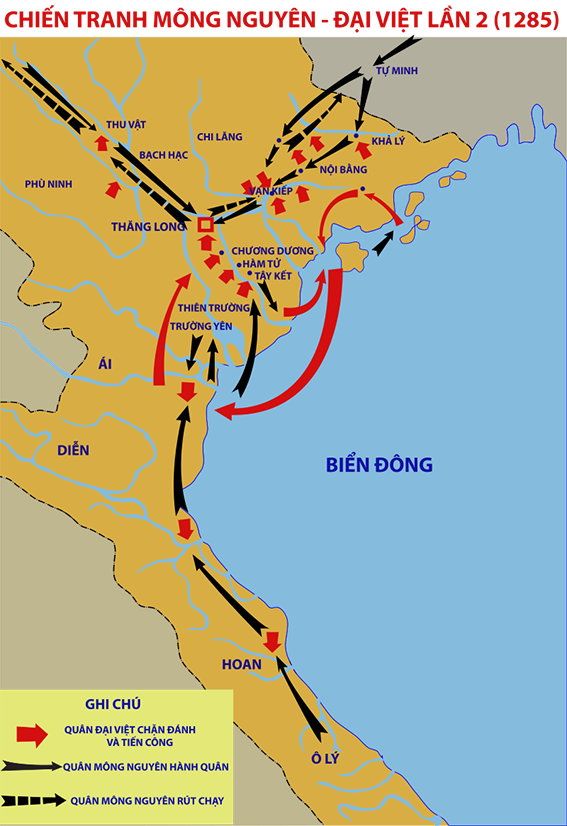
Scheme of the 2nd War between the Yuan-Mongols and the Đại-Việt in 1285.
(Crédit Photo : wikipedia.org - Lưu-Ly)
The Armed Forces of TRẦN Dynasty, being in posession of a solid Military Statute and the national union of the wole Đại-Việt people, had again with illustrious Generalissimo Trần-Hưng-Đạo and his military officers defeated heroically 300.000 Yuan-Mongol warriors in the 3th invasion of Đại-Việt, during nearly 4 Months - from the end December 1287 into the end April 1288 - throughout celebrious Battes of Chi-Lãng, of Nội-Bằng, of Vạn-Kiếp, of Phả-Lại and about all of the Bạch-Đằng-Giang Navy Battle...
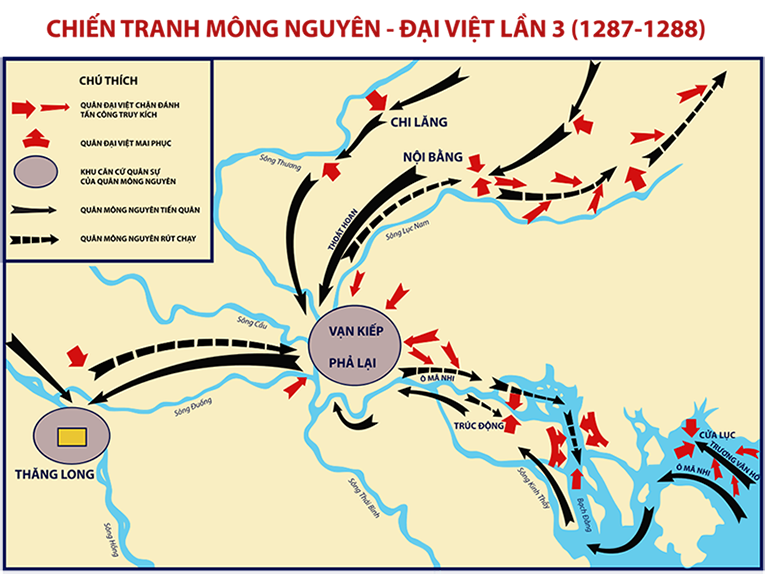
Scheme of the 3rd War between the Yuan-Mongols and the Đại-Việt
leaded from the end of December 1287 into the end of April 1289.
(Crédit Photo : wikipedia.org - Lưu-Ly)
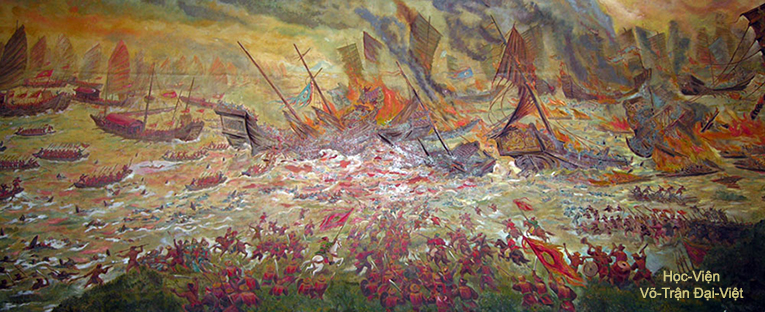
Painting of Bạch-Đằng Giang Navy Batlte in 1288
(Photo Credit :: Viện Bảo-Tàng Quân-Đội)
The celebrious feats of arms from Đại-Việt under Trần Dynasty defeating Yuan-Mongol invaders armies in 13th century, had been repercussions on to Japon really 200 years afterwards... And in 15th century, the japanese royalty had dispatched a diplomatic delegation to Đại-Viiệt country, in view to demand a hearing with Đại-Việt Emperor for presenting the letter of credit and for submitting to Đại-Việt the protectorat of Japan as well as to demand the opening of a sea route trade via the estuary harbour from Hội-An. This Treaty of Protectorat between Đại-Việt and Japan had been conserved in National Museum of Saigon since at this time untill the year of 1975.
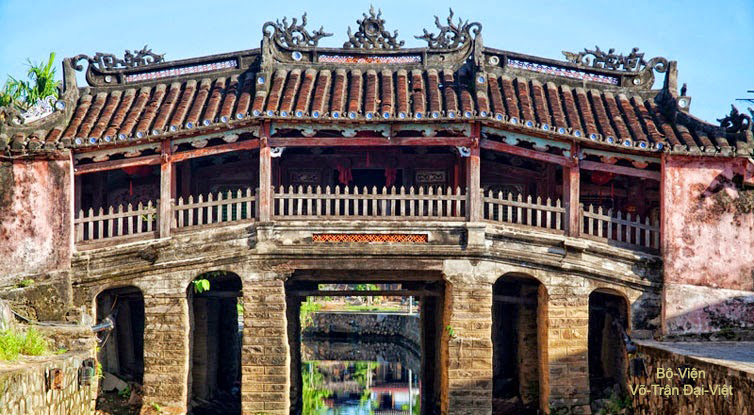
The Pagoda-Bridge (Chùa-Cầu) thrown across the River Thu-Bồn at Hội-An,
built by Japoneses in 16th century.
(Photo Credit :: zoomtravel.com;vn)
I – The Military Statute
II – The Military Horses Riding
III – The War Horses
IV – The Coats of Horses
Bình-Định SA-LONG-CƯƠNG TRỊNH Quang Thắng |
Bibliography :
« Comments from a Library » ("Vân Ðài Loại-Ngữ") from Lê-Quí-Ðôn, 1773.
« Summary of Việt-Nam History » ("Việt-Nam Sử-Lược") from Trần-Trọng-Kim.
« Complete Book of Việts History » ("Việt-Sử Toàn-Thư") from Phạm-Văn-Sơn.
Copyright © 2004 - 2019 by ACFDV - All rights reserved.
